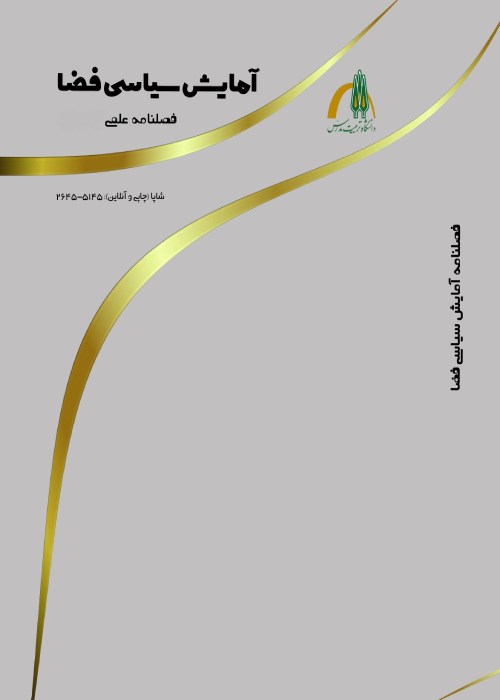Investigating the influencing factors in Defense Planning
Developments in recent decades have caused wars to undergo extensive transformations and changes in terms of nature, corresponding to this change of governments, in order to face these developments and changes, it is necessary to change one's outlook and perception in designing strategy so, they can move in harmony with the evolution of the nature of wars and reduce the challenges and damages caused by it on their territory as much as possible. In the meantime for prevention of the strategy of defense of the territory according to the new nature of wars, it can have a prominent position. Because the land defense plan as one of the land plan approaches is trying to rationally organize the land according to its capacities and potentials with an emphasis on defense and security. In a way that can maintain the security and integrity of the land, guarantee the independence and protection of the people against any attack and threat of the enemy, insecurity, create gaps and faults, wise and appropriate distribution of vital places and sensitive centers and infrastructures, balanced distribution of defense forces- It provided security in the territory on according to the capacities and facilities of the territory. Based on this, the present research seeks to extract the effective components on the design of the defense strategy of the Middle East countries, so that based on it, they can reduce the insecurity and costs (financial and life) to the extent while maintaining their survival to reduce the space of the country.
The current research method is based on content analysis and library and field sources (interview) were used to collect information. In the library findings section, components have been extracted from past theories and works, and in the second step, the components have been confirmed by interviewing seven of the scientific-military elites and reaching theoretical saturation.
The studies conducted to extract the components affecting the defense of the Middle East countries show the absence of a comprehensive scientific theory and work in this field, and various theories and works have been used to extract the components. In this context, 12 theories and eight experiences of defense training of different countries have been examined and analyzed, and based on them, 130 components have been extracted and provided to experts and thinkers in this field. The field of theoretical saturation has been extracted with seven scientific-military elites. The results of the examination of the theories and approaches that have been collected in the field of topics related to the defense of the land, along with the interviews that have been conducted with related experts and thinkers, show that both parts are Various factors on the diversity and extent of 130 components have been effective in designing the defense strategy of the Middle East countries, which are given in the form of 15 dimensions in the form of the following table based on importance:Table 3: Distribution of research components in 15 dimensions derived from theories and approaches Row Dimensions Components 1 Economic dimension Income and its level; job and its type; economic interactions; amount and type of production; employment and unemployment; standard of living; economic justice; economic policy; Financial problems; Economic potential and capacities 2 Political dimension Power structure; political management of space; distribution of power; form of interaction; Law and political regulations; political planning; political divisions; The shape and composition of the nation; the political position of space; The level and manner of communication (transnational-transnational) 3 Geopolitical dimension Regional geopolitical structure; global geopolitical structure; Geostrategic position, status of water resources, position of countries with border rivers, degree of dependence on common water resources, common energy resources, location of energy resources, geopolitical behavior, transit position, common cultural identity, regional geopolitical position 4 Cultural dimension Customs; Religion; Language; ethnicity (race); culture of effort and employment; culture of participation; life style; social attitudes; Communication culture 5 Social dimension Social norms and anomalies; Community Relations; social gap; type and form of family; social form and structure; family and its relations; social boundaries; social organizations 6 Security dimension Border and demarcation (transnational); border (national); transnational threats; sanctions and boycotts and their effects; national unity and cohesion; ethnic and religious diversity; spatial distribution of ethnic and religious groups; The population density; political organization of space; Security technologies 7 Military dimension Military equipment; the efficiency of forces; defensive styles (strategies); the structure of forces; natural capacities and potentials; military shortcomings and limitations; number of enemies; the country's settlement region; location of military centers; military power and structure; War and its forms 8 Demographic dimension life expectancy; sexual ratio; education level; number of population; age structure; Growth rate; marital status; population density; Family size; Migration; Births and deaths 9 Scientific-health dimension Cyberspace; Bioterorism; Drug production capacity; Medical Equipment; treatment methods; the potential of elitism; the amount of scientific leap; Public health level
The results of the investigations carried out in this research show that the defense based on the transformations and developments that have taken place in different fields has undergone extensive changes and necessarily the governments in order to be able to face this changes that have taken place in the field of threats and technologies, etc., to update and make their defense strategies efficient, they should be able to take a comprehensive and up-to-date approach to the defense of the land. According to the findings of the present research, it shows that land defense as one of the forward strategies of the governments in an up-to-date and comprehensive manner includes 15 dimensions and 130 components that should be used in the design of the strategy should be considered.
- حق عضویت دریافتی صرف حمایت از نشریات عضو و نگهداری، تکمیل و توسعه مگیران میشود.
- پرداخت حق اشتراک و دانلود مقالات اجازه بازنشر آن در سایر رسانههای چاپی و دیجیتال را به کاربر نمیدهد.



